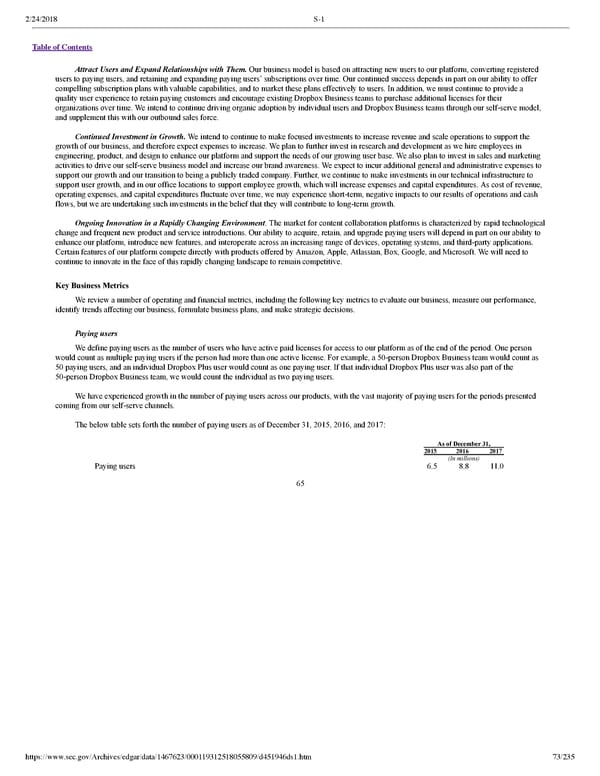2/24/2018 S-1 Table of Contents Attract Users and Expand Relationships with Them. Our business model is based on attracting new users to our platform, converting registered users to paying users, and retaining and expanding paying users’ subscriptions over time. Our continued success depends in part on our ability to offer compelling subscription plans with valuable capabilities, and to market these plans effectively to users. In addition, we must continue to provide a quality user experience to retain paying customers and encourage existing Dropbox Business teams to purchase additional licenses for their organizations over time. We intend to continue driving organic adoption by individual users and Dropbox Business teams through our selfserve model, and supplement this with our outbound sales force. Continued Investment in Growth. We intend to continue to make focused investments to increase revenue and scale operations to support the growth of our business, and therefore expect expenses to increase. We plan to further invest in research and development as we hire employees in engineering, product, and design to enhance our platform and support the needs of our growing user base. We also plan to invest in sales and marketing activities to drive our selfserve business model and increase our brand awareness. We expect to incur additional general and administrative expenses to support our growth and our transition to being a publicly traded company. Further, we continue to make investments in our technical infrastructure to support user growth, and in our office locations to support employee growth, which will increase expenses and capital expenditures. As cost of revenue, operating expenses, and capital expenditures fluctuate over time, we may experience shortterm, negative impacts to our results of operations and cash flows, but we are undertaking such investments in the belief that they will contribute to longterm growth. Ongoing Innovation in a Rapidly Changing Environment. The market for content collaboration platforms is characterized by rapid technological change and frequent new product and service introductions. Our ability to acquire, retain, and upgrade paying users will depend in part on our ability to enhance our platform, introduce new features, and interoperate across an increasing range of devices, operating systems, and thirdparty applications. Certain features of our platform compete directly with products offered by Amazon, Apple, Atlassian, Box, Google, and Microsoft. We will need to continue to innovate in the face of this rapidly changing landscape to remain competitive. Key Business Metrics We review a number of operating and financial metrics, including the following key metrics to evaluate our business, measure our performance, identify trends affecting our business, formulate business plans, and make strategic decisions. Paying users We define paying users as the number of users who have active paid licenses for access to our platform as of the end of the period. One person would count as multiple paying users if the person had more than one active license. For example, a 50person Dropbox Business team would count as 50 paying users, and an individual Dropbox Plus user would count as one paying user. If that individual Dropbox Plus user was also part of the 50person Dropbox Business team, we would count the individual as two paying users. We have experienced growth in the number of paying users across our products, with the vast majority of paying users for the periods presented coming from our selfserve channels. The below table sets forth the number of paying users as of December 31, 2015, 2016, and 2017: As of December 31, 2015 2016 2017 (In millions) Paying users 6.5 8.8 11.0 65 https://www.sec.gov/Archives/edgar/data/1467623/000119312518055809/d451946ds1.htm 73/235
 Dropbox S-1 | Interactive Prospectus Page 72 Page 74
Dropbox S-1 | Interactive Prospectus Page 72 Page 74